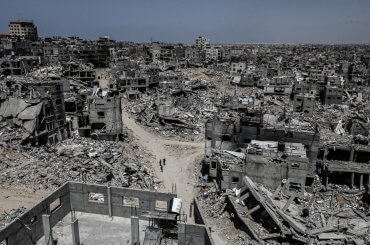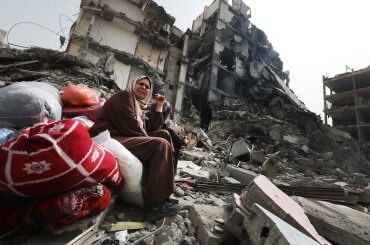I am a Palestinian citizen of Israel since day one of its establishment. I studied in the USA and am familiar enough with American media to appreciate the lead place of The New Yorker in it as well as the dearth of positive articles on Palestinians, not to mention Palestinian citizens of Israel, in this realm. You can imagine how surprised I was to discover that my fellow Palestinian, Ayman Odeh, was featured front and centre in the coveted pages of the prime intellectual weekly of the United States (Seeds of Peace: Ayman Odeh’s unlikely crusade, The New Yorker, Jan.25, 2016.) And the lengthy account is by the periodical’s chief editor, no less, David Remnick. I read it right away and was duly impressed by the many accolades my friend Ayman is awarded in it.
Only four months before I had read another positive piece by Ruth Margalit about the Palestinian writer from Israel Sayed Kashua (An Exile in the Corn Belt: Israel’s funniest Palestinian writer decamps to the Midwest, The New Yorker, Sept. 7, 2015.) Now I was positively elated. Finally our issues were getting significant attention in America, I wanted to believe. Average Americans can no longer claim that they didn’t know we existed. That has protective value for us; it makes it less likely that anyone will rub us off or throw us out – such existential fears resurface every time we hear sabre rattling at the borders with Lebanon or Syria. Exaggerated you say? But the top military echelons have leaked such ‘drawer’ contingency plans.
I’ve reread both articles repeatedly. Very well written indeed. But there is a bitter aftertaste. Its source in the end is quite basic: both writers unequivocally favour Israel over my ilk and me. I know my two friends, the subjects of the articles, live with that and so do I– we have done so for decades. We are aware of the American tendency to favour our Jewish co-citizens that parallels the same injustice those co-citizens inflict on us daily by making us second class to them. In fact it is systemic throughout American media, academia and politics. Over the many decades of suffering this disenfranchisement we have developed the ability to sniff its existence at a considerable distance.
Sayed Kashua:
The older of the two articles, the one about Kashua, rates a score of eight on my scale of one to ten degrees of favoritism. True, Margalit does justice to her subject, our Palestinian Hebrew-language author, in her literary assessment of him. He comes across as the insightful and skilfully self-and-other-mocking writer whose weekly column I have followed in the Israeli daily, Haaretz. And that is great. But Margalit tones down the negativity of the negative in Israel every chance she has. Kashua’s TV series, Arab Labor, for example is reported to have won him fans even among “taxi drivers and supporters of Beitar.” Margalit has to explain to her American reader what that means. “[A] Jerusalem soccer club whose right-wing fans have been known to chant ‘I hate all Arabs.'” I live in Israel. And this stuff is online. I know Beitar’s chants. They usually are “Death to Arabs,” a chant heard regularly at political rallies of the right. I don’t believe I’ve come across the chanting of “I hate all Arabs”.
But the death chant seems too vulgar for Margalit to include. Hating is less uncivil. Theodor Herzl threw himself into Zionism after he heard people shouting “Death to the Jews” in Paris. Is there any question how the New Yorker would report that?
While describing Kashua’s living arrangement in Jerusalem, the author fails to explain Israel’s near total residential segregation by ethnicity as well as the separate educational systems and the prioritization of the Jewish towns and schools over the Arab ones. The American reader who lacks the background to appreciate the steep gradients in both arenas, is unlikely to grasp the significance of Kashua’s move to the Jewish Jerusalem suburb. The exceptional circumstance of his escape with his wife and children from the depravity and drudgery of state enforced segregation to the upscale adequacy of the American suburb such as it is, is willingly glossed over. Only recent violence is highlighted.
Then this:
“Many Arabs, like Kashua, consider themselves both Palestinian and Israeli, a bifurcated identity that speaks to years of strife and longing.”
Very nicely put! And in such a poetic turn of phrase, almost romantic. When in fact the real experience that people such as myself can’t stop bemoaning is one of loss of land and culture and the absolute negation of everything that we once were proud of. “Bifurcated identity” is far too mild a term for the dormant anger and disappointment that roils us. Israel destroyed a thriving culture and is hard at work replacing it with another from which it excludes us. That is not only “bifurcated.” It is a bitch! I know because I live it.
But why raise contentious issues when all we are talking about is TV entertainment. Margalit provides some facts on that front:
“Although Arab Israelis represent a fifth of the the population, in 2011 they made up one per cent of the characters on national TV and, according to a report by the agency that oversees commercial broadcasts in Israel, ‘usually appear in the context of crime and violence.'”
Yet there is no field, socio-economic, cultural, educational or juridical, where the two groups approach anything like equity. Shouldn’t that be mentioned as background? And it is all based on rules and regulations grounded in the legislative inventiveness of the “only democracy in the Middle East.” And we haven’t touched on the trigger-happy security forces who kill fellow Arab citizens with impunity.
Ayman Odeh:
I can’t stop admiring David Remnick’s astuteness in picking Ayman Odeh as his subject and for spotlighting Nardin, his good wife and daughter of my neighbours and friends. The two exemplify the generation we, the levelheaded in Israel, hang our hopes on. But Remnick’s account too is skewed starting with the context-setting. In defining the Palestinian Nakbah he states:
“In 1947-48, the Palestinians rejected a United Nations plan to create a Jewish state and an Arab state by partition….”
Except that this occurs after a successful decades-old European colonial project that continues to swallow up Palestine and erase Palestinians to this day.
Another example of guile:
“This was the moment when Yasir Arafat, who had ordered terror attacks against Israelis for decades, and Yitzhak Rabin, who had reportedly ordered Israeli soldiers to “break the bones” of young Palestinians who hurled stones at them during the first intifada, signed a peace agreement and shook hands on the White House lawn.”
Notice the confirmed “terror” labeling of Arafat against the “reportedly” qualification when speaking of Rabin. Though it is a historical fact that Rabin had commanded over the killing of many more Palestinians than Arafat ever did Israelis. One doesn’t have to include mention of massacres of 1948 like that of Lydda– but you could have balanced the language a little.
Closer to home, Remnick speaks of Ayman living in Haifa, “a mixed city.” Haifa (like the handful of other so-called mixed cities in Israel) is a Jewish city with an Arab slum or two, sometimes bordered with barbwire. “Mixed” glosses ghettoisation.
Likewise, he refers to Land Day as “the commemoration among Palestinian Israelis of a 1976 rally.” This severely undercuts the event’s significance, an occasion commemorated across the entire Palestinian nation as the first peaceful uprising against Israel after 1948. I lived it. We intended to strike for one day and Rabin ordered his crack troops in tanks into our peaceful villages and killed six of our youth. It certainly was not “a rally” and you are docked brownie points again. So you get an eight as well.
Conclusion:
To be honest, I have mixed feeling about the New Yorker’s new awareness of the existence of the minoritized Palestinians in Israel. I would probably part with an arm and a leg to have one of my short stories featured in your pages, David Remnick. But would you do that if the spirit of such a story were to go against the pro-Israel grain? To judge by my analysis so far, I would have to demonstrate a more accepting, if not admiring or loving attitude toward my country of citizenship if I am to even be considered. Mind you, I am not accusing anyone of selling out. But both Ayman – a parliament member — and Sayed–a writer in Hebrew–are easy to integrate into the image of a democratic and inclusive Israel. And it is the shaky groundwork upon which they are introduced that limits the impact they may have.
This piece was originally published at The Institute for Palestine Studies.



Expect Israel to set up one of its Palestinian ghettos as a model integrated community, much like Theresienstadt, the Nazi concentration camp that the Nazis presented to outsiders (and on film) as a model Jewish settlement. Undoubtedly David Remnick would publish an article about it in the New Yorker under the title “Israel, a model integrated Society.”
Bull’s eye, Yourstruly.
In fact, the idea of a Theresienstadt show-window would be proposed to the Zionist entity by Remnick, a specialist, the Yahoo being too much of a cave-dweller to have the brainstorm.
One wonders what cataclysm would result if an article about Palestinians was written by (duh-duh-duuuuuuuuuh!) another Palestinian? That much truth might have resulted in seizures all over New York.
This piece comes a nit late, nearly a month after the article about Ayman Odeh appeared in the New Yorker. The reason is that I submitted it first to the New Yorker editors on the slim chance that they might publish it in whole or in part whether in print or on their website. When they didn’t, a fact that in itself confirms the bias I tried to point out in the body of the article, I decided to submit it to more sympathetic media sites in the hope that Ayman Odeh and Sayed Kashua will read it and get convinced that they and their nation are worthy not only of exposure and reviews but also of unbiased reporting.